by Kimble Charting Solutions
See the original article >>
Monday, June 6, 2011
Corn Market Remains Tight, Volatile
Corn growers in the northern and eastern Corn Belt regions are currently struggling to decide whether to accept prevented planting payments, take a chance at planting corn in June or switch to another crop. Meanwhile, the corn market is trying to estimate just how much 2011 corn that U.S. farmers will both plant and harvest.
“Out of the 92.2 million acres that USDA projected would be planted to corn this spring, we’re probably down to a little less than 91 million acres that might actually be planted,” says Chad Hart, Iowa State University agricultural economist. “Even in normal conditions, we would have expected to harvest around 85 million acres, out of the 92.2 million projected acres planted. With plantings below 91 million acres, I expect harvested acres to be down at least a million acres, as well. That would put us in the 83- to 84-million-range for corn-harvested acreage.”
As a result, global corn stocks are likely to remain tight for another year or so, says Hart. “The U.S. produces 40% of the world’s corn, so if we’re behind in production, the world is behind, too,” he points out.
Corn isn’t the only feed and food product with tight supplies right now, adds Hart. U.S. wheat growers in the southern plains are currently coping with drought while growers in the northern plains are contending with cold, soggy soils. On the other side of the globe, China is having wheat production problems, as well.
“China’s feed grain situation is pretty tight,” says Hart. “Their food and feed wheat crops are struggling, and they are the world’s largest wheat producer. China is also second in corn production behind the U.S.”
Having tight global supplies of both wheat and corn at the same time generally favors higher-than-normal prices for both crops, says Hart. “U.S. corn farmers are in a good spot right now – there seems to be more upside potential than downside,” he adds.
Still, a surge in oil prices might be all it takes to tumble commodity grain prices, notes Hart. “Normally high energy prices help to boost corn prices,” he says. “However, if oil rose to $125/barrel, more than likely it would decrease corn prices, because our export demand would decrease significantly.”
USDA recently confirmed that China had purchased some U.S. corn in March. However, Hart says that it’s still anyone’s guess as to whether China will make any more U.S. corn purchases again this year or next.
Although it may be pricey, farmers might consider making some moves now to protect their price floor against a possible future price drop, without having to guarantee delivery, advises Hart. “When you see a market that is bouncing around like this corn market has for the last few months, it shows how volatile the market is,” he says. “High volatility in a market means a high cost for price protection.”
Market concerns are even higher over the remaining 2010 corn crop than the potential 2011 corn crop, notes Hart. As evidence, he cites the current cash corn market in the central Corn Belt.
“Right now (June 1), there is a 35-40¢ basis in cash prices over what nearby futures prices are offering for mid-September,” he says. “The bottom line is that the grain elevators and ethanol plants in central Iowa are recognizing that there might not be enough corn to be had come late August and early September.”
Given the late planting that has gone on this year, not many farmers will be able to take advantage of the attractive price premiums being offered for early September delivery, even if farmers planted early maturing varieties, notes Hart. “On the other hand, we’re still seeing nearby futures prices a good $2/bu. above what production costs are,” he says. “So, there’s likely going to be more opportunities for corn farmers to lock in a very profitable price, whether they deliver early or not.”
Etichette:
articles,
commodity,
commodity article,
corn,
grains,
market articles
Week in Review: The Power of Zero To Be Tested?
By Global Macro Monitor
The S&P500 and Dow Jones Industrials suffered their worst weekly loss of the year, both down 2.3 percent. The U.S. and European equity indices had bearish outside moves and all major global equity indices we track closed the week below their 50-day moving averages. Asia fared better only due to the fact they closed before the release of Friday’s weak employment data. Investors and traders have definitely sold in May and gone away in the S&P500, Dow Jones, and all three European equity indices, which have had negative closes for five weeks in a row.
On the positive side, the Brazilian BOVESPA looks like it’s trying to put in a bottom and the Shanghai Composite was able to hold its January’s important closing low of 2677 after trading down to 2689 early in the week. We will be watching Asia closely at the open on Sunday night as their equity markets have a chance to react to Friday’s employment report.
Apple, the general of this bull market, closed up 1.79 percent on the week and could be a catalyst for a market bounce if Mr. Jobs surprises at the company’s worldwide developers conference this week. Many traders are short the stock going into the conference on the expectation nothing of significance will be announced. Shorting Apple? Ouch!
U.S. Treasury bonds closed stronger, but were unable to take out Wednesday’s highs even on the dismal employment data. The dollar closed down for the second straight week and we find it interesting that risk assets have been unable to rally on the weak dollar. Though it’s too early to tell, keep this on your radar as the weak dollar/risk on trade may be a changin’.
The power of zero (interest rates) as a risk-on market prop may be about to face its first serious test. The toxic brew, which would signal something more serious than a garden variety correction, would be the combination of a weaker dollar, equity and bonds moving lower, crude oil and gold moving higher. Not yet a high probability event, in our opinion, and let’s hope we don’t see it, but keep it on your McSwan list. A credible and sustainable long-term debt/fiscal program included in a Congressional debt ceiling deal would go a long way in easing the concerns of the ratings agencies and increase the confidence of foreign investors in their dollar holdings. Further dithering will be costly.
Good luck this week!

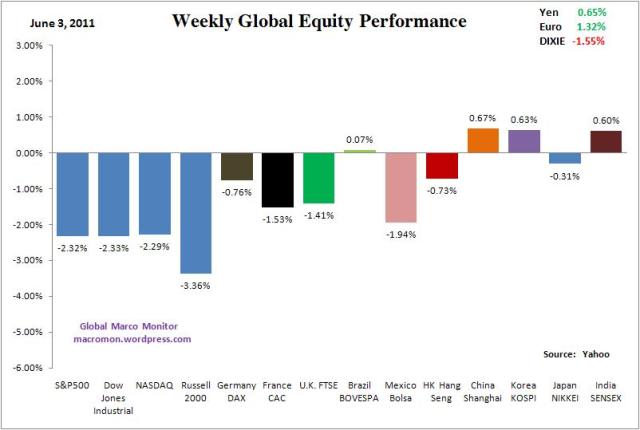

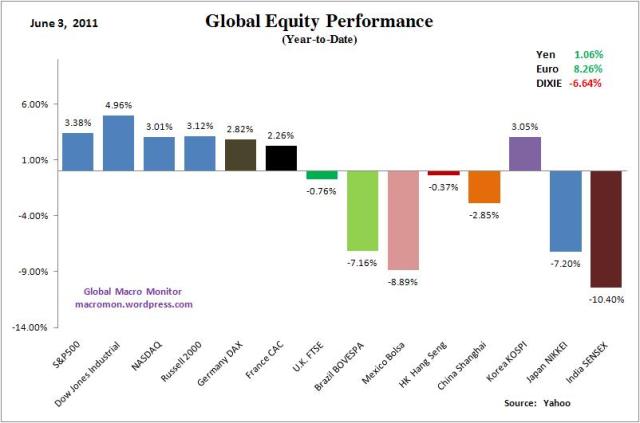

See the original article >>
Etichette:
Analysis Technic,
articles,
Finance article,
Index,
market articles
Basis of the Stocks Bear Market Rally
By: Tim_Wood
Of late, I have been receiving questions asking how I can justify saying that the advance out of the March 2009 low is a bear market rally. After all, doesn't a rally of some 26 months have to be a bull market? No, it does not and I continue to believe that this is a bear market rally that will ultimately separate Phase I from Phase II of a much longer-term and ongoing secular bear market. I have addressed this topic before, but for some reason these questions are being asked again, so I will address them here again. The explanation that this is a bear market rally within a much longer-term secular bear market lies with the historical bull/bear market relationships, Dow theory phasing and values.
Let's first look at bull and bear market relationships. But, before I even begin, I want to clarify that cycles have absolutely nothing to do with Dow theory. Cycles and Dow theory are two completely different disciplines. However, they can be used to compliment each other if we understand both disciplines.
Now, with that being said, the bull and bear markets of the late 1800's and very early 1900's, which Dow, Hamilton and Rhea wrote about, are one in the same as the upward and downward movements of the 4-year cycle. In other words, the upside portion of a 4-year cycle was the same thing as a bull market in accordance with Dow theory and the downside portion of the 4-year cycles were the same as the bear markets in accordance with Dow theory.
But, beginning in 1921, these bull and bear market periods began to grow in duration. I feel that this is a direct result of the growth in population. As our country grew, more and more people began investing and as a result, the bull and bear periods became longer. In turn, bull and bear markets evolved into a series of multiple 4-year cycle events. For example, the first bull market to consist of multiple 4-year cycles ran from 1921 to 1929 and consisted of two 4-year cycles. The low in November 1929 was a 4-year cycle low. The rally, or "Secondary Reaction," as it would be termed in accordance with Dow theory, that followed was the upside portion of a 4-year cycle that topped in only 5 months. Once this "Secondary Reaction" was over, the DJIA moved down below the previous 4-year cycle low and into the 1932 4-year cycle low, which proved to be the bear market bottom. I would also like to point out that the 1921 to 1929 bull market advanced a total of 568% from the 1921 4-year cycle low at 67 on the DJIA to the 1929 4-year cycle top at a high of 381.
The next great bull market began with the 4-year cycle low in 1942 and ran to the 4-year cycle top in 1966. This time the "Primary" bull market was comprised of a series of six 4-year cycles and advanced a total of 1,076% from the 1942 4-year cycle low at 93 on the DJIA to the 1966 4-year cycle top at a high of 1,001 on the DJIA. Note that in percentage terms of the advance, this bull market advance was roughly double the preceding great bull market of the 1920's. The bear market that followed was also a series of 4-year cycles. From the 1966 4-year cycle top, the bear market moved down into the 1974 bear market low. This was a series of two 4-year cycles.
Now, I want to focus on the bear market declines. Prior to the first great bull market that ran between 1921 and 1929, the bear markets averaged some one-third the duration of the previous bull market. This relationship has also held true with the extended bull market periods as well. For example, the 1921 to 1929 bull market was 8 years in duration and the 1929 to 1932 bear market was 3 years, making the bear market duration 37.5% of the preceding bull market. The 1942 to 1966 bull market was 24 years in duration and the 1966 to 1974 bear market was 8 years, which was 33.3% of the duration of the preceding bull market.
From both a cyclical and a Dow theory perspective, the last and greatest bull market of all time began with the 1974 4-year cycle low. Some say that it began at the 1982 low, but in reality, that is when the new bull market became obvious. The low occurred in 1974 and Richard Russell called that low at the time using Dow theory. The bull market that began in 1974 carried price up into the 2007 top, which was a period of 33 years and consisted of a series of eight 4-year cycles for a total advance of 2,390%. Note that once again this bull market advance more than doubled the magnitude of the preceding bull market advance, which is also another consistency.
Now, if we apply the normal bull bear relationship of approximately one-third, then given that the last great bull market ran some 33 years, this bear market should last until somewhere late in this decade. I will add to that, the more they monkey around with the natural forces of the market, the longer they are apt to drag things out and the worse it will be. Because the 2009 low occurred only 17 months after the 2007 top, that low falls far short of the normal one-third relationship that has historically been seen. Therefore, based on these historical relationships I do not believe that we have seen the bear market bottom.
According to Dow theory, each bull and bear market period has three separate phases. This phasing is an important aspect of the Dow theory that is most often over looked. The 1966 to 1974 bear market is a perfect example of a bear market, its three phases and the rallies separating each of the phases. Therefore, I will use that chart to illustrate this concept.
Referring to the chart above, Phase I of the second great bear market began at the top in February 1966. This top was confirmed under Dow theory in May 1966. From this top the market declined into the Phase I low in October 1966. This Phase I decline is marked in blue on the chart above and it carried the market down some 25%. From this Phase I low the typical rally that serves to separate Phase I from Phase II began. This rally carried the market up some 26 months and is marked in green on the chart above. During this 26 month advance you can see that there were a couple of false breakdowns that the market was able to recover from and inevitably pushed higher. In fact, with the advance into 1968 bettering the 1967 secondary high points, a traditional Dow theory bullish trend change even occurred.
But, those who understood Dow theory phasing would have understood that this was a bear market rally separating Phase I from Phase II of a much longer-term bear market and not a new bull market. I can also assure you that the longer this rally lasted the more bullish and more convinced the public became that a new bull market was underway. Also, when the market would recover from these false breaks, I strongly suspect that the bullish sentiment must have been off the chart. I'm also sure that the Dow theorists continued to warn, but few understood or listened to these warnings. Then, with the Dow theory trend change in 1968 I'm sure that the public was convinced that a new bull market was underway. They probably proclaimed that anyone stating anything other than this "obvious" bull market needed to be admitted for a psychiatric evaluation. After all, this was "obvious" and anyone not seeing it was obviously blind.
However, in spite of the false breaks, the bullish sentiment, false recoveries and claims of new bull markets, the Dow theory phasing prevailed and the decline into the Phase II low carried the market down some 36% to new lows over a 17 month period. This Phase II decline is marked in red on the chart above.
Then came the rally separating Phase II from Phase III of this ongoing secular bear market. This rally carried the market up 66% over a 32 month period. This advance is also marked in green on the chart above. Once again, the world was convinced that the bear market was over. After all, the market had made a new high. How in the world could we still be in a bear market with the market at new highs? Those Dow theorists had to be wrong this time around because this time was different and it was "obvious" with the market at a new all time high.
But, once again, the Dow theory phasing prevailed and Phase III took the market down 45% into the final Phase III low. This low marked the bottom of the second great bear market. This time, those who understood the Dow theory were able to recognize this bottom for what it was, as did Richard Russell. History tells us that the public was so beaten down by the time the Phase III low had occurred that once again they did not listen to the Dow theorists. Bearish sentiment was sky high and anyone pushing stocks at this point, again needed counseling. Who in their right mind would buy stocks after suffering through these declines? However, the Dow theory phasing was proven correct and the third great bull market, that ran until the 2007 top, was born at the 1974 Phase III bear market bottom.
This brings us to our current chart below. From the 2007 top, the Industrials dropped some 53% over a 17 month period into the bear market Phase I low in March 2009. This decline is marked in blue on the chart below. From that low the typical rally separating Phase I from Phase II began. Just as with the 1966 to 1968 rally, the longer this rally lasts, the more convinced the public will become that this is a "new bull market." I know from my research what this bear market rally top will look like because I have identified a common DNA Marker that has appeared at every major top since 1896. I'm covering these details and developments in the research letters and updates at Cycles News & Views. This rally will top in accordance with those DNA Markers and will allow me to identify it as well. Therefore, based on my knowledge of Dow theory phasing and the historical bull and bear market relationships I do not believe that we have seen the bear market bottom or that the advance out of the March 2009 low is a new bull market.
Let's now look at value, which is another historical marker of secular bear markets. Historically, the dividend yield will be roughly equal to the price earnings ratio at secular bear market bottoms. I have used the S&P data here because I did not have this data as far back on the Industrials. At the 1932 bear market bottom the yield was 10.50% and the P/E was just under 10. At the 1942 bear market bottom the yield was 8.71% and the P/E was 7.3. At the next great bear market bottom in 1974 the yield was 5.9% and with a P/E of 7.24. If we take this same reading at the 1982 low the yield was 6.2% and the P/E was 6.9. For the record, these P/E ratios are based on Generally Accepted Accounting Principles and not the bogus George Orwellian methods of today. At the 2009 low, the P/E was 26 with a dividend yield of 3.2, which is hardly at par. Therefore, based on this historical measure, there is also no indication that the 2009 low marked the bear market bottom.
The top of the rally separating Phase I from Phase II of this ongoing bear market is looming. The manipulation and efforts to keep the market afloat will not matter. The natural forces of the market will prevail. By understanding the environment in which we are operating and by knowing how to identify the top we can prepared for what lies ahead. I was able to identify the top in 2000, which is well documented. All throughout the 4-year cycle advance into the 2007 top I warned that the efforts to prop up the markets would not work, that it was stretching the 4-year cycle and that it would ultimately only serve to make matters worse and I was also able to identify that top, as well. Again this was all documented. Few listened. I am again warning. The manipulation does not matter. This time, it is a bear market rally and the Phase II decline will come, once the proper setup is in place.
Stock Market Cycles Analysis
By: Clif_Droke
Let’s take a step back and examine the intermediate-term outlook for 2011 based on some observations we made earlier this year.
Earlier we discussed the outlook for 2011 based on an “echo analysis” of the Kress cycles. In January, Ned Davis Research produced a chart which combined the stock market’s 1-year, 4-year and 10-year tendencies. This composite chart suggested that most of this year’s gains will occur in the first half of the year. Our own composite work based on the Kress cycle “echo” phenomenon also suggested that the stock market could make a significant peak in the April-May time frame and that most of the market’s gains would be made in the first half of 2011.
Earlier we discussed the outlook for 2011 based on an “echo analysis” of the Kress cycles. In January, Ned Davis Research produced a chart which combined the stock market’s 1-year, 4-year and 10-year tendencies. This composite chart suggested that most of this year’s gains will occur in the first half of the year. Our own composite work based on the Kress cycle “echo” phenomenon also suggested that the stock market could make a significant peak in the April-May time frame and that most of the market’s gains would be made in the first half of 2011.
In the Feb. 4 report we did an in-depth echo analysis in which we looked at the 6-year cycle going back to 2005, the 10-year cycle going back to 2001, the 30-year cycle back to 1981, and the 60-year cycle back to 1951. We concluded that the February-March time frame tends to be a rally period for the stock market with April being a “blow off” or peak month. We found that in the previous “echo” periods of the analysis that the market had a tendency to post interim peaks in late April or early May.
For instance, going back to the year 1951 we found that the stock market posted an interim peak in the early part of May that year in keeping with the common theme of all four years. In the 30-year echo year of 1981 the market’s final peak was made at the end of April. In the 10-year echo year of 2001 the market’s peak was in mid-May.
In the Feb. 4 report we wrote, “There are two conclusions that can be made from this echo analysis of the four key Kress cycles. The first is that the stock market tends to rally in February with a significant short-term peak in March. The second conclusion is that a significant intermediate-term top tends to occur in the May time frame.” Also in the Feb. 4 report it was noted that Ned Davis Research had produced a chart which combines the stock market’s 1-year, 4-year and 10-year tendencies. This composite chart suggested that most of this year’s gains will occur in the first half of the year.
With the benefit of hindsight we can see that this echo analysis proved itself useful in predicting the late April/early May top this year. There was a tradable rally in February with a correction March, followed by another significant peak at the start of May. So far the Kress cycle “echo analysis” has proven to be reasonably correct in predicting the first five months of 2011. The question we want to examine tonight is what the second half of 2011 will likely show based on the Kress cycle echoes.
To answer this question it will help us to once again go back and examine the stock market chart patterns from the key years 2005 (6-year cycle), 2001 (10-year cycle), 1981 (30-year cycle) and 1951 (60-year cycle). Once we’ve done this we can average out the patterns to form a composite for what the second half of 2011 might look like. By way of disclaimer, please keep in mind that “markets and snowflakes are never exactly the same,” so this is only a rough approximation and should be used as an absolute rule by itself.
Before we continue with our echo analysis, I’d like to point out that while I’ve always employed the S&P 500 Index (SPX) as my preferred benchmark for the U.S. broad market this has only been true since about 2002 at the previous 12-year cycle low. Prior to this the Dow 30 Industrial Average was a useful proxy for the broad market and was much more representative of the broad market (and economy) than it is today. Another point worth mentioning is that the SPX was unduly influenced by its tech stock component during the tech stock crash of 2000-2002, which explains why the SPX significantly underperformed the Dow for much of that bear market.
Starting with the 10-year Kress cycle echo, in 2001 the Dow 30 Index peaked in early February and followed this up with a higher peak in May. The May 2001 peak proved to be the high for that year. This was followed by a steady decline into September, at which point the dominant interim weekly cycle bottomed. Of course the year 2001 was a bear market year and this influenced the path stock prices took for much of that year.
This year has seen a continuation of the bull market and as such the comparison isn’t analogous. The point worth emphasizing here is that instead of a sustained decline in the coming summer months like we saw in 2001, the upcoming months could see a lateral trading range. This is what would have happened in the summer of 2001 had it not been for the severe downward pressure exerted by the tech stock market deflation.
Next we have the 30-year echo which takes us back to 1981. The Dow peaked at the end of April ’81 as you can see here. This is a chart that I suspect will be very instructive for us in the upcoming weeks. As you can see, while the Dow peaked in late April there was a secondary peak in mid-June which came just short of equaling the late April peak. In other words, it was a classic “double top.” As we’ve been discussing in recent reports, the technical indicators have been suggesting a rally is in the process of unfolding which could bring the major indices back up to the May 2 peak – or close to it. A failure for the market to achieve a higher high above the May 2 peak from here would be interpreted as a bearish omen, especially with the Fed’s quantitative easing (QE2) Treasury purchasing program coming to an end at the end of June.
The 1981 chart of the Dow shown above is instructive only insofar as it shows a double top into the May-June time frame. What happened after this in ’81 probably won’t happen this year as the market still has a lot of support from the 6-year cycle peak scheduled for late September/early October.
We’ve discussed the possibility that the summer months will witness a lateral trading range with the May 2 top forming the upper boundary of this range. The final element of our echo analysis, namely the 30-year echo from 1951, provides us with more of a positive slant. What’s interesting about 1951 is that the stock market pattern from that year is nearly identical with the year to date. There was an early year rally and short-term peak in February followed by a higher – and more significant – peak at the beginning of May. The S&P 500 Index bottomed in late May that year and rallied into mid-June.
After a double bottom in July 1951, the S&P proceeded to rally to new highs before peaking in October, at which time the 6-year cycle peaked (just as it will this coming October). Here is where the potential similarity ends with 2011. While it’s possible the market could make a token new high heading into the upcoming 6-year cycle peak in late September/early October, the bigger likelihood is that the market will go into range-bound mode once QE2 expires on June 30.
Etichette:
Analysis Technic,
analysis technic article,
articles,
Index,
market articles
Towards a Worldwide Inflationary Depression, Collapse of the Anglo-American Empire
By: Bob_Chapman
According to our calculations we have been in an inflationary depression since February of 2009. Everyone looks back on the deflationary depression of the 1930s as a benchmark or a reference. As far as we are concerned the 1930’s depression only ended when the powers behind government arranged another war. Few talk about the recession of the early 1920s, which only lasted two years and was caused by the newly formed Fed, which financed US participation in World War I. They raised interest rates, which enticed citizens to save, which provided money for loans for research and expansion. The Fed, other than raising rates, stayed neutral, as did the Treasury. The result was the recession ended quickly. A bad story with a happy ending, which contributed to the roaring 20s, which the Fed eventually turned into a depression via their interference.
There was no deficit spending in the 1920s and funded debt fell by 1/3rd. That went on from 1945 to 1960. Today we have a different kettle of fish, which consists of perpetually kicking the can down the road, hoping some miracle will save the day, when those who caused these problems know full well the situation cannot now be saved without purging the system and allowing maleinvestment and speculation to die a normal death in bankruptcy. The Fed, Wall Street and speculators cannot bring about recovery, but they try anyway. Those who agree with these elitists are fools and they will pay a high price for not listening.
The Treasury is issuing $2.16 trillion in debt annually and if the Fed purchases 80% that works out to $1.7 trillion a year. As QE2 comes to end this month there will be few to buy that $1.7 trillion in treasuries and the system will collapse into deflationary depression. That means the Fed has to keep doing what it is doing. If the Fed stops we’ll have deflationary depression with a year. If they continue doing what they are doing we will have hyperinflation in 2 to 2-1/2 years.
Today’s worldwide crisis centered in the US, UK and Europe did not have to happen. It was not caused by incompetence and greed. It was designed to destroy the economic and financial system to a point where the inhabitants of these countries would beg for world government. It began, as we know it on August 15, 1971, when the US went off the gold standard. Since then the dollar has lost 98% of its value versus gold, silver and in some cases other currencies. As this became the monetary future, events were put in place to move almost all industry and some services out of the US, UK and Europe, better known as free trade, globalization, offshoring and outsourcing. In addition unsustainable debt was created to make sure the system collapsed. Of course, as far as the elitists are concerned, there is no problem - there is just a period of adjustment. Part of this adjustment is the extension of the short-term debt limit to $16.3 trillion from $14.3 trillion.
When, we ask, will Social Security and Medicare be cut? Trillions in taxes were paid for this old age and survivor’s pension. From its very inception the money was looted from the general fund and the bonds issued are not worth the paper they are written on. Mandated benefits can never be covered as the taxes are at this very moment being looted. This is a reflection of what is happening in the entire global system, a hallmark of socialism. As the debate rages, we can assure you the elderly will get screwed again with major cuts in Social Security and Medicare.
As we said earlier the longer the inevitable is delayed the worse the result will be. We do not know what untoward event will bring on the inevitable, but it is there lurking somewhere. When it happens it will be like a bolt out of the blue.
The Anglo American empire is in an ongoing state of collapse, which they deliberately caused themselves in order to subdue and enslave humanity. We saw the faux adulation afforded to the illegal alien who calls himself president. The Anglo American special relationship still is firm at the upper levels. This includes their joint role of guardians of civilization. Just more Illuminist sanctimonious crap. The key to globalist power is control of the world banking system and we plan to take that away from them. This is not 1348, and there will be no exile from Venice. There will only be long prison terms, a confiscation of all family wealth and execution for those who have betrayed our country. This time the Illuminists will suffer the unthinkable. Something they have not suffered in the last 1,000 years.
The Fed is now holding just under $2.8 trillion in bonds of which they say $1.6 trillion is in Treasury paper. The rest is in Agency securities and toxic bonds. By the end of June they should be over $3 trillion. Our question is what is the real figure? How much do they have or are they committed for with other nations that are not visible? Remember, it took two years and a trip to the Appeals Court to force the Fed to tell us what they were secretly hiding from us. As a result they have no credibility, so anything they say has to be taken with a grain of salt. From June to June, we expect that $1.6 trillion to grow to $3.3 trillion and the Fed may well have to disperse another $500 to $850 billion to keep the system afloat. That would bring to figures to $3.8 to $4.15 trillion. That should be enough to keep the system afloat, provide 50% hyperinflation and tend to the beginnings of WW III. The creation of war will be the distraction needed to force inflation, debt and monetary problems into a second position. Who worries about money and purchasing power when they may be dead shortly? This is the pattern the elitists have followed for centuries.
At the same time the amount of Treasuries purchased by foreign investors and other nations are falling and that we believe will continue. The question then arises how much additional paper will the Fed have to absorb – another $600 billion a year? We do not know that answer, but it doesn’t look good.
We believe after having seen Mr. Strauss-Kahn set up for extinction as head of the IMF and as the main challenger to Mr. Sarkozy, that there is a power struggle going on between the European and the Anglo American interests to above all make sure that the dollar remains the world reserve currency no matter what the circumstances. This is really the main battle that is going on. The Europeans want the SDR, the British and Americans the dollar. The latter’s thinking is that since WW II the US has again and again saved the world economy, being the engine that has driven all economies. In the recent case of China it is the same as well. If US markets had not approved and opened their markets to China’s exports and most favorite nation treatment, China would not be where it is today. The American elitists believe the dollar deserves its position no matter how much they have damaged it.
You can see Europe going all out to make sure French Finance Minister Christine Lagarde becomes head of the IMF. They want a European running the IMF in spite of the fact that Strauss-Kahn said in 2007 that the next leader of the IMF would not be a European. That is why the Mexican finance minister, Mr. Carstens, threw his hat in the ring. He is in reality the US designate. An additional reason that has brought Lagarde strong European support is that Sarkozy wants to get rid of her, because she is doing a good job. Another reason we see conflict within the inner sanctum is that Greece could bring down the ECB and the euro and it seems the elitists would like that. It switches focus away from a falling dollar and destroys its main competitor, the euro. This is a titanic struggle that most observers are missing. It makes Strauss-Kahn’s arrest and termination at the IMF and his fall from socialist party grace a diversion. The battles are for the continued supremacy of the US dollar and more control over the IMF via Carstens. US interests want a Greek default and a euro breakup. The US rating agencies continue to attack the ratings of all of the weak euro counterparts and at the same time short European country bonds. The UK is in this with the US up to their eyeballs. The US and UK have left Europe to swing in the wind. This is what is really going on in Europe. Remember, there is no honor among thieves.
Late developments from our contacts in Greece tell us the bankers, EU and IMF had best forget about collateralizing debt (Mnemonic). The entire country is now aware of what the bankers are up too. What put the frosting on the cake was that a publication in the Netherlands said as a result of the secret deal, the Turks would get a Greek Island and raise their flag over it. That has really enraged the Greeks. PM Papandreou told 30 of his party legislators (Voulefles) that if they didn’t vote for collateralization he will fire them and replace them with people off the street. He obviously thinks he is a dictator because that is beyond his legal authority. Each day 150,000 people are surrounding the Vouli, the Parliament and the members are growing. PM Papandreou now only moves by helicopter, obviously fearful of assassination. One thing is for certain he will have difficulty ever living in Greece again. A woman professor said on TV that a Patriotic resistance has already started in Crete and in many smaller cities; people are signing up in the new movement. The police cannot handle the massive crowds and the military is securely behind the people. The bankers had best give it up and walk away. They are going to lose this one and it means the end of the euro zone and the EU.
Switching back we must remind you again that the Fed is monetizing $900 billion, not $600 billion as you have been told. Without that number the Fed could not have accomplished all of its Treasury buying. Of the almost $2.8 trillion in bonds some $900 billion are toxic waste, that is about 33%. We do not know their value, but we would guess it to be close to $200 billion, which the American taxpayer will get to pay for – that is a $700 billion loss, if that is what it works out to be. By what has happened over the last few years we conclude the Fed is the main source of economic instability. There is very little savings and that is understandable with virtually zero deposit interest rates. The Fed can throw money and credit at the problems, but in the final analysis you have to have a large pool of savings to borrow from. For some time there was negative savings. Presently they are 4% to 5%, which is inadequate to launch a permanent recovery. Quantitative easing only temporally solves the problem. The Fed’s approach has driven what savings there are and funds from QE2 into speculation and that does not create recovery. Loose monetary policy diverts funding away from positive recovery activities to speculation and into bubbles. The Fed’s policies will bring about one or two conclusions: hyperinflation is obvious as an extension or present policies. The other is a cessation of creation of money and credit, which will bring about a falling economy and economic contraction. At least at this juncture the Fed continues on Plan A – expansion. At the same time we are told an increase in interest rates are a long way off. Toward this end the Fed’s balance sheet is quickly expanding and we do not see any slowdown ahead. An increase from 15% to 17% might not seem like much, but it is, especially when savings numbers are falling causing a loss in underlying momentum. This is negative for Treasuries because 80% of buying has to continue to come from the Fed via monetized money created out of thin air.
If anyone believes higher inflation is going to act as a governor on monetary growth they are mistaken. The Fed has little concern regarding inflation and price stability, if they did they wouldn’t be doing what they are doing. The government lies about the CPI figures and the Fed swears to it. The figures are far higher than stated and anyone who believes official figures is very remiss in professional evaluation.
Between the Fed and Congress $1.8 trillion has been spent to achieve 1.8% growth in the first quarter and all indications are that the economy is slowing again. We thought the carryover in the first quarter would have been 2-1/2% to 3-1/4%, but that didn’t happen. We expected a further slowing in the second quarter to 2% and then negative growth for the remainder of the year. We’ll stick to that projection, but the slippage will come from a lower level. Unless QE3 is already underway we should see minus 2% for the second half of the year. What professionals and investors have to understand is that what the Fed is doing doesn’t work and the Fed knows that. The longer they create money and credit the higher inflation will rise along with gold, silver and commodities and the lower the dollar will fall versus other currencies, but more importantly the lower the US dollar will fall versus silver and gold.
The same kind of condition exists in Europe with the same systemic corruption we see worldwide. The current Greek government is an excellent example. It is probably the most dishonest since WWII. And that includes the mid-80s communist government of George’s father, Andres of the Papandreou crime family. As we look back we wonder what EU countries were thinking of when they knew they were subsidizing a lifestyle Greeks could never afford? Government workers were retiring at 50. Living standards have been cut 30% to 40% and retirement is now 70 years. These are appropriate measures, but the changes should have been stretched over years. The shock has essentially crippled the economy. Even Draco was not that cruel. The very concept agreed to by the Greek administration to put $400 billion in assets into the hands of foreign experts is something that will harbor strife for years to come. It must be remembered that the banks and governments should have never made those loans in the first place. Who is to know whether these fellow EU socialists are going to do any better than the Greeks have done? The European and British banks want their money back, and it will be interesting to see if they are successful.
In the US a similar situation exists. Even if there is debt approval on August 2nd, the damage caused by the impasse will continue far into the future because printing of money and credit by the Fed is certainly not the answer and financial people worldwide are well aware of that. If legislation is not passed, real interest rates will rise from today’s ridiculously low levels very quickly. That means bonds would plunge along with the stock market, which in turn means all Treasury fiscal needs would have to be filled in a vacuum by the Fed. Hyperinflation and a dollar collapse would be the final outcome.
As a result of this predicament the only real asset the US has that is worth anything are the portfolios of Fannie Mae, Freddie Mac, Ginnie Mae and FHA. Instead of nationalization their holdings would be sold off to collateralize outstanding US debt to the debtors. That would be $6 trillion worth. Or perhaps 401Ks and IRAs could be commandeered by Congress in behalf of the state and given to creditors. The Americans thus robbed of their lifetime assets would receive worthless government guaranteed annuities. Those assets would probably be exchanged for perhaps $0.50 on the dollar or $0.33 on the plunging dollar. Can you see what your government has been doing and continues to do to you in order to further enrich those in government, on Wall Street and in banking? This is what you have worked so hard for – betrayal. This is probably where this is all headed and you are the victims. You cannot do much about the situation, as the Greeks and others cannot, short of a military coup. This is where you stand and this is where this is all headed and you had best prepare for it, because if you do not you will be very sorry.
Etichette:
articles,
Economy article,
Finance article,
market articles
Stock Market S&P 500 Structure and Momentum
By: Piazzi
In this post of May 20, I used weekly Momentum Cycle, OEW aggregate trend, and Market Alignment Index indicators to sum up the state of S&P in 4 words
“Structurally positive, but weak!&
In that same post, I said:
“It’s not a disastrous situation. All three indicators are still above zero denoting a positive tilt to aggregate trend (as measured by OEW) and aggregate structure (as measured by MAI). The weekly momentum cycle we just saw is also above zero (dropping but above zero). So the situation is not terribly negative, but it reeks of internal weakness, like a patient with a serious yet curable disease. The cure of the market’s disease at this time is money deployed on the bid side.”
It seems like our proprietary indicators were correct spotting structural weakness 2 weeks ago
Let’s look their current status
Weekly momentum cycle (red graph) is still pointing down
Notice that the price low of March has so far not fetched a momentum low. Price has now dipped to an important area of support (1295-1305). A break of this area may accelerate selling and make the March low susceptible to a retest or even a break.
This is a daily chart with OEW aggregate trend, and Market Alignment Index (MAI) indicators
If you compare the current status of chart above with its status of the post of May 20 you will notice that the indicators have deteriorated rather significantly.
These indicators measure aggregate trend and aggregate price structure of all constituents of the index. Deteriorating structure cannot hold price and that’s what we warned then and that’s what we see now.
The only somewhat positive is that, while mid-term OEW and daily MAI have dipped below their respective March lows, price itself is still above its March low. This is price positively diverging from structure at this point. Will that lead to a bottom good enough soon for at least a tradable rally?
All I can say is what I said back in the post of May 20:
Market structure reeks of internal weakness, like a patient with a serious yet curable disease. The cure of the market’s disease at this time is money deployed on the bid side — we need buyers.
In that post of May 20, I also said:
“Weak structure is a sign that buyers are lacking. We need buyers to hold support, strengthen the internals and then lift the index. We need them while mid-term trend is up and index is above support”
Buyers did not show and we now have a mid-term downtrend.
For me to take bulls seriously, they should take a very small first step and get a swing low. They should then take a very small next step and get a short-term uptrend. After that, we’ll see how good they are maintaining a short-term uptrend and squeezing the shorts.
Etichette:
Analysis Technic,
analysis technic article,
articles,
Finance article,
Index,
market articles
WHAT HAPPENS WHEN THE GOVERNMENT TIGHTENS ITS BELT? (PART 2)
In a recent post, I used a simple teeter-totter diagram to show how the government’s financial balance is related to the private sector’s financial balance in a closed economy. With only two sectors – government and non-government – I showed that a government deficit necessarily implies a surplus in the private sector.
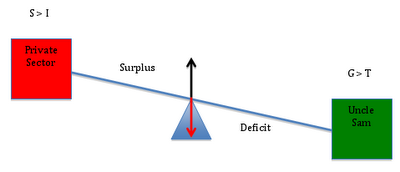
As expected, this accounting truism ruffled the feathers of a flock of readers who have been programmed to launch into an anti-government tirade at the mere mention of the public sector and to regard the dangers of deficit spending as an unimpeachable fact. And while you’re certainly entitled to your own political views, you are not, as Senator Moynihan famously said, entitled to your own facts.
Other, less impenetrable minds, agreed that the private sector’s financial position must improve as the government’s deficit increases in a closed economy, but they argued that I had not demonstrated anything meaningful because I ignored the financial flows that occur in an open economy.
I still hope to convince both groups that they are acting against their own economic interests when they support policies to balance the budget or reduce the deficit, either by raising taxes or cutting government expenditures. So let’s continue the exercise and, as promised, extend the argument to the more realistic open-economy in which we actually live.
In an open economy, income flows into and out of the domestic economy as residents and foreigners buy goods and services (exports minus imports), make and receive payments such as interest and dividends (factor income) and make net transfer payments (such as foreign aid). Each country keeps track of these payments using a balance of payments (BOP) account, which summarizes the international monetary transactions that take place between the home country and the rest of the world. The BOP has two primary components – the current account and the capital account – and we can use either one to show whether, on balance, money is flowing into or out of a country.
In an open economy, income flows into and out of the domestic economy as residents and foreigners buy goods and services (exports minus imports), make and receive payments such as interest and dividends (factor income) and make net transfer payments (such as foreign aid). Each country keeps track of these payments using a balance of payments (BOP) account, which summarizes the international monetary transactions that take place between the home country and the rest of the world. The BOP has two primary components – the current account and the capital account – and we can use either one to show whether, on balance, money is flowing into or out of a country.
When we incorporate these international flows, we transform the closed-economy accounting identity I used in my previous post:
[1] Domestic Private Surplus = Government Deficit
into the open-economy accounting identity shown below:
[2] Domestic Private = Government + Current Account
Surplus Deficit Balance
or, equivalently,
[3] Domestic Private = Government + Capital Account
Surplus Surplus Balance
When the current account balance is positive, it means that we in the private sector (households and domestic firms) are accumulating net financial claims on foreigners. When it is negative, they are accumulating net financial claims on us. Thus, a positive current account implies a negative capital account and vice versa.
To see this in the context of the teeter-totter model, let’s initially hold the public sector’s balance constant at zero (i.e. let’s assume the government is balancing its budget so that G = T). With the government budget in balance, Uncle Sam is a “weightless” entity on the teeter-totter, so that the private sector’s financial position will simply reflect the “weight” of the capital account. Suppose, first, that the current account is in surplus (i.e. the capital account shows an equivalent deficit):

The image above depicts the benefit (to the private sector) of a current account surplus (a.k.a a capital account deficit), and it is the outcome that many of you accused me of sidestepping in my previous post. Of course, the U.S. does not have a current account surplus, so let’s address that point before moving on. (And lest anyone begin to hyperventilate, I’ll also address the fact that G ≠ T). First, the current account.
Sticking with (G = T) for the moment, we can show how a current account deficit impacts the private sector’s financial position. As the capital account moves from deficit (diagram above) into surplus (diagram below), we see that the private sector’s financial position moves from surplus into deficit.

But does this all of this hold true in the real world, or is it some kind of economic chicanery? Let’s check the facts.
Equations [2] and [3] above are not based on economic theory. They are accounting identities that always “add up” in the real world. So let’s firm up the discussion about the implications of government “belt tightening” by running through some examples using the real world data found in the table below (Hat tip to Scott Fullwilir for sharing the file. All of the data comes from the National Income and Product Accounts (NIPA) and the Flow of Funds.)
Let’s begin with the data from 1998 (Q3), when the public sector deficit was just 0.01% of GDP and the current account deficit was 2.56% of GDP. Plugging these numbers into equation [2] above, the identity tells us (and the data in the table confirm) that the private sector’s balance must have been:
[2] Domestic Private Sector’s Balance = 0.01% + (-2.56% )= -2.55%
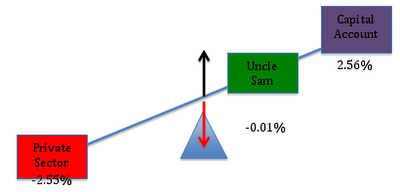
Here, we can see that the private sector’s financial position was deteriorating because it was making large (net) payments to foreigners. Because this loss of financial resources was not offset by the public sector, the private sector’s financial position deteriorated.
To see how a bigger government deficit would have improved the private sector’s financial position, let’s look at the data from 1988 (Q1). As a percent of GDP, the current account balance was 2.59%, nearly the same as before, while the government’s deficit came in at a much higher 4.2% of GDP. We can use Equation [2] to see effect of the larger budget deficit:
[2] Domestic Private Sector’s Balance = 4.2% + (-2.59%) = 1.61%
In this period, the private sector ends up with a surplus because the government’s deficit was large enough to more than offset the negative effect of the current account deficit.
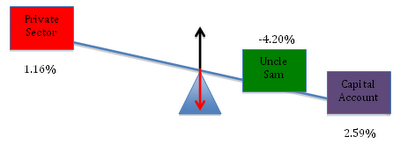
Again, this is simply a property of the sectoral balance sheet identities. Whenever the government’s deficit is too small to offset a deficit in the current account, the private sector will experience a net loss. The result my ruffle your feathers, but it is an unimpeachable fact.
So let’s go back to President Obama’s comment and the reason I wrote this blog in the first place. The President said:
“[S]mall businesses and families are tightening their belts. Their government should, too.”
Wrong! When we tighten our belts, it means that we are trying to build up our savings. We do this by spending less. But spending drives our economy. Sales create jobs. So unless Obama has a secret plan to reverse three decades of current account deficits, the Government needs to loosen its belt when we tighten ours. If it doesn’t, then millions of us will lose our shirts.
** An aside: I am aware that I have said nothing about the usefulness of the spending projects, the waste and inefficiency that exists with many government programs, cronyism, inequality, etc., etc. These are legitimate and important questions, but they are not the focus of this analysis. I wrote this series of blogs to try to get people to understand the interplay between the private, public and foreign sectors’ balance sheets. Criticizing me for not addressing a myriad of other issues is like reading Old Yeller and complaining, “What about the cat? You’ve completely ignored the genus Felis!”
Etichette:
articles,
Economy article,
Finance article,
market articles
CHINA DIVESTS 97% OF TREASURY BILL HOLDINGS – WHAT DOES IT MEAN?
So it looks like QE2 indeed managed to scare China out of the dollar. This is the portfolio shifting previously discussed that’s been dragging down the dollar even though, fundamentally sound, as Fed Chairman Bernanke correctly stated. When China (and Japan) offered to buy Spanish and other euro zone national government debt to ‘help out’, the euro zone fell for that one, watching their currency rise against their better judgment with regards to their euro wide exports.
Maybe Fed Chairman Bernanke is aware of this, and has assured China he does favor a strong dollar as per his latest public statements, and let them know that QE3 is unlikely, and has ‘won them back’? No way to tell except by watching the market prices. And with most everyone out of paradigm with regards to monetary operations, there’s no telling what they all might actually do next. What we know is that the world fiscal balance is tight enough to be slowing things down, and looking to keep getting tighter.
QE/lower overall term structure of rates removes interest income from the economy, and shifts income from savers to bank net interest margins. If China’s growth is going to slow dramatically, it’s most likely to happen in the second half as they tend to front load their state lending and deficit spending each year. And all the while our own pension funds continue to allocate to passive commodity strategies, distorting those markets and sending out price signals that continue to bring out increasing levels of supply that are filling up already overflowing storage bins.
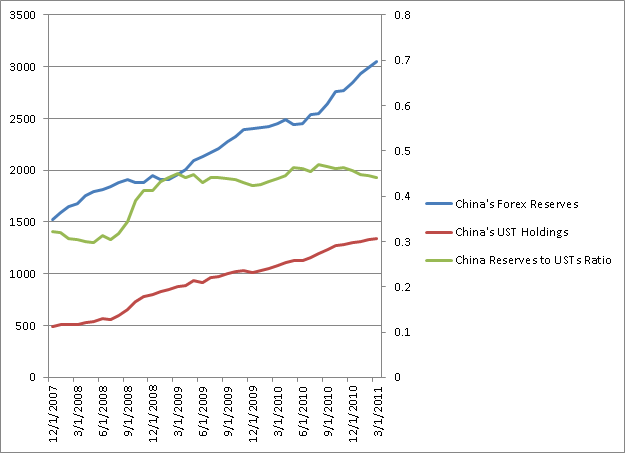
Note in particular that reserve accumulation has been high and rising recently, though UST accumulation has been moderate.
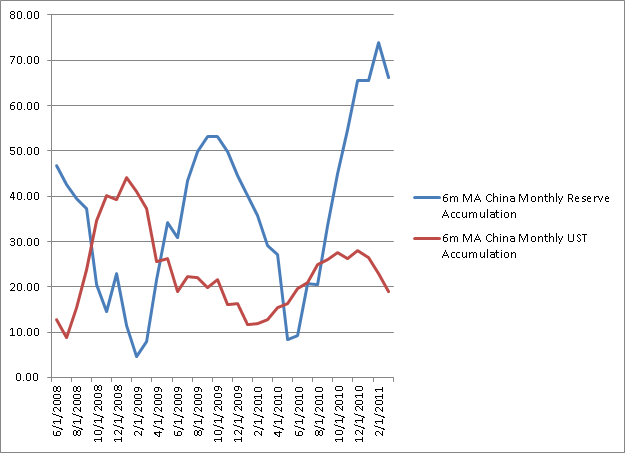
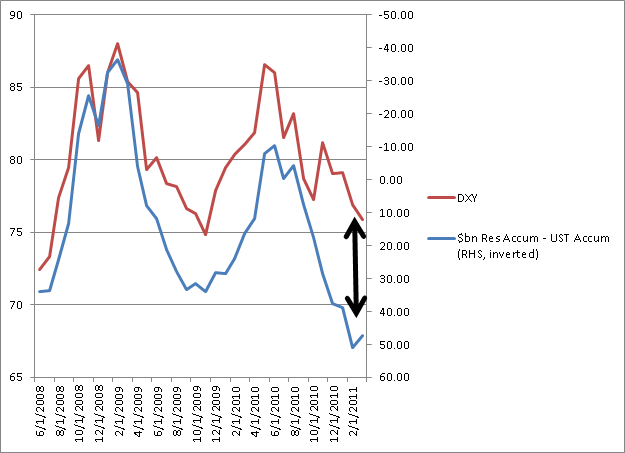


Etichette:
articles,
Economy article,
Finance article,
financials,
market articles
Macro Week in Review/Preview 6/4/2011
Last week’s review of the macro market indicators looked for more upside for Gold and a drift higher for Crude Oil. The US Dollar Index looked headed to test the recent lows while US Treasuries continue higher. The Shanghai Composite looked to continue lower after falling out of the symmetrical triangle while Emerging Markets head higher toward resistance. With continued stable and low Volatility the Equity Index ETF’s are diverging, with the IWM looking better to the upside while the SPY and QQQ need to break resistance to join it and so are looking better to the downside. This divergence should resolve soon but could also lead to more sideways action.
The short week unfolded as the charts laid out for Gold and Crude Oil. The US Dollar Index and Treasuries also moved as suggested but with Treasuries reversing mid week. The Shanghai Composite and Emerging Markets flew flags for the week and with Volatility rebounding but not much. The Equity Index ETF’s resolved their divergence issue by weeks end, Wednesday and proceeded lower. What does this all mean for the coming week? Let’s look at some charts.
As always you can see details of individual charts and more on my StockTwits feed and on chartly.)
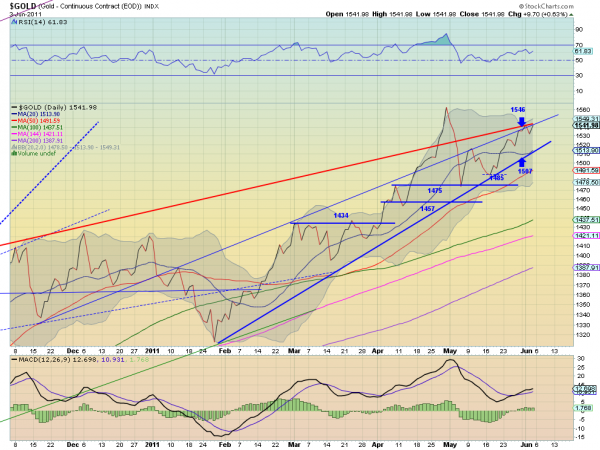
Gold Weekly,$GC_F
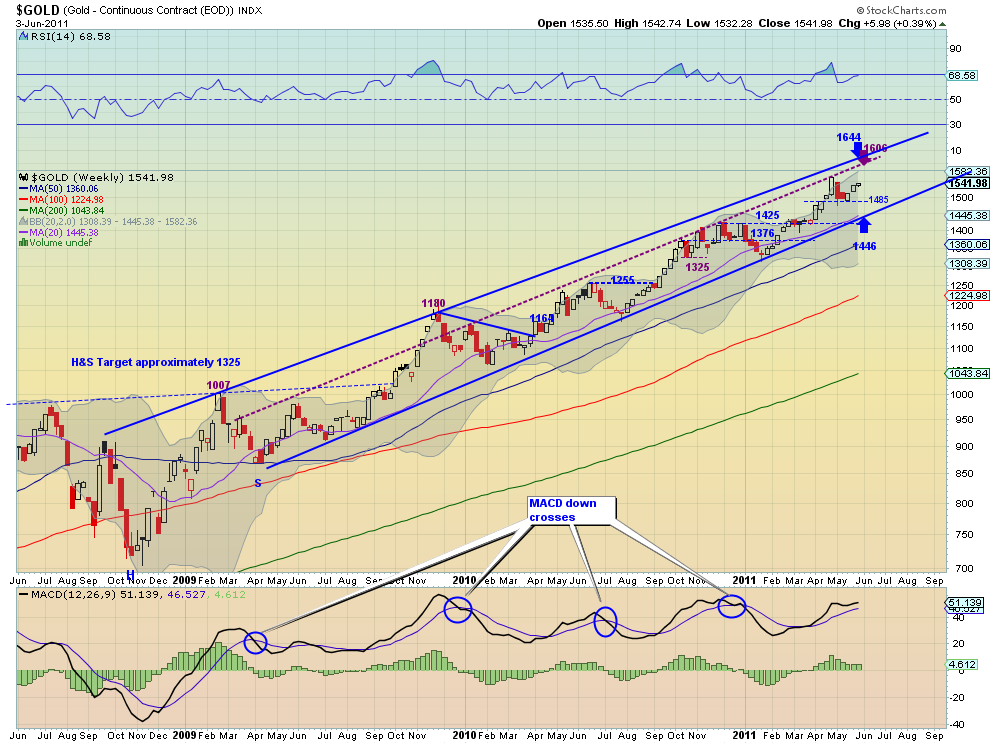
Gold remained in contact with resistance of the rising trend line on the daily chart for the entire week. The Relative Strength Index (RSI) shows a slight trend upward and the Moving Average Convergence Divergence (MACD) a gradual increase. Both support a run higher either through the trend resistance or along it. The weekly chart shows Gold in the clear and rising with a rising RSI and a MACD that is starting to grow slowly again. Both timeframes suggest more upside in the coming week. If it gets above the 1546 resistance area the previous high at 1563.20 is the next resistance and then 1600. Look for pullbacks to find support at 1517 and 1510.

West Texas Intermediate Crude Weekly,$CL_F
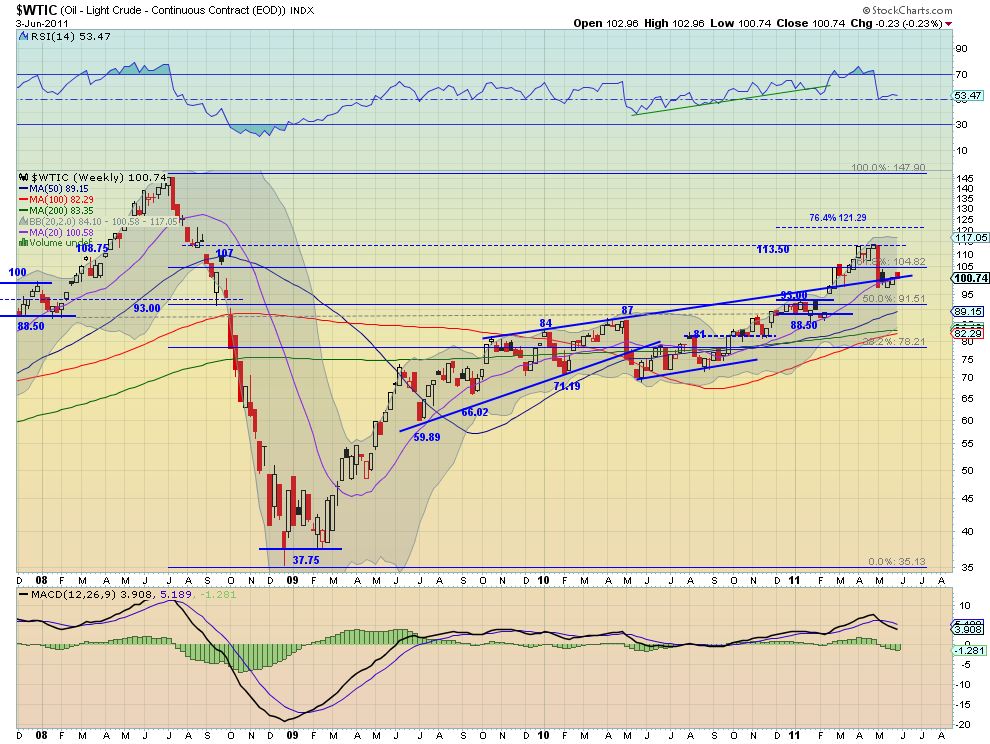
Crude Oil spent the week bouncing off of the 100 day Simple Moving Average (SMA) and the slowly rising trend line resistance, currently at 102.45. The RSI has been flirting with the mid line on the daily chart as the MACD levels. Also the SMA have started to flatten as the Bollinger bands (BB) are tightening. Consolidation before a move. The weekly chart shows a drift higher alternating around the extension of the resistance line from 2008 and the 20 week SMA. The RSI on this timeframe is holding in bullish territory but the MACD is diverging lower. This suggests a bias for the BB tightness to resolve lower. Look for next week to continue a sideways to slightly upward drift with a break of 104.82 to the upside or 97 to the downside signalling a next trend direction.
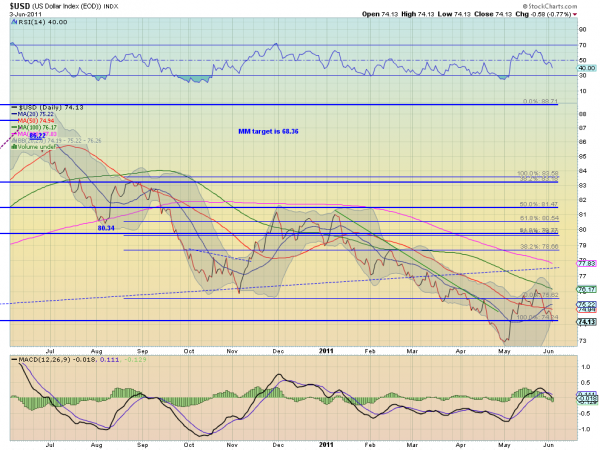
US Dollar Index Weekly,$DX_F

The US Dollar Index moved lower for the week and looks to continue that in the coming week. The daily chart shows it breaking below the 2009 lows again at 74.24 and resting just above previous support at 74.10 from 2008 and slightly outside of the lower BB. But with the RSI looking sharply lower and the MACD crossing negative this week the slight break of the BB on the daily chart should not stop it. The weekly chart shows a continuation off of the Marubozu from last week, with a falling RSI and a flat MACD. Support comes next at 73 with only 72 and 71.50 lower keeping it from making new all time lows. Targets get ugly down there, but for the time being look for it to continue disintegrating next week.
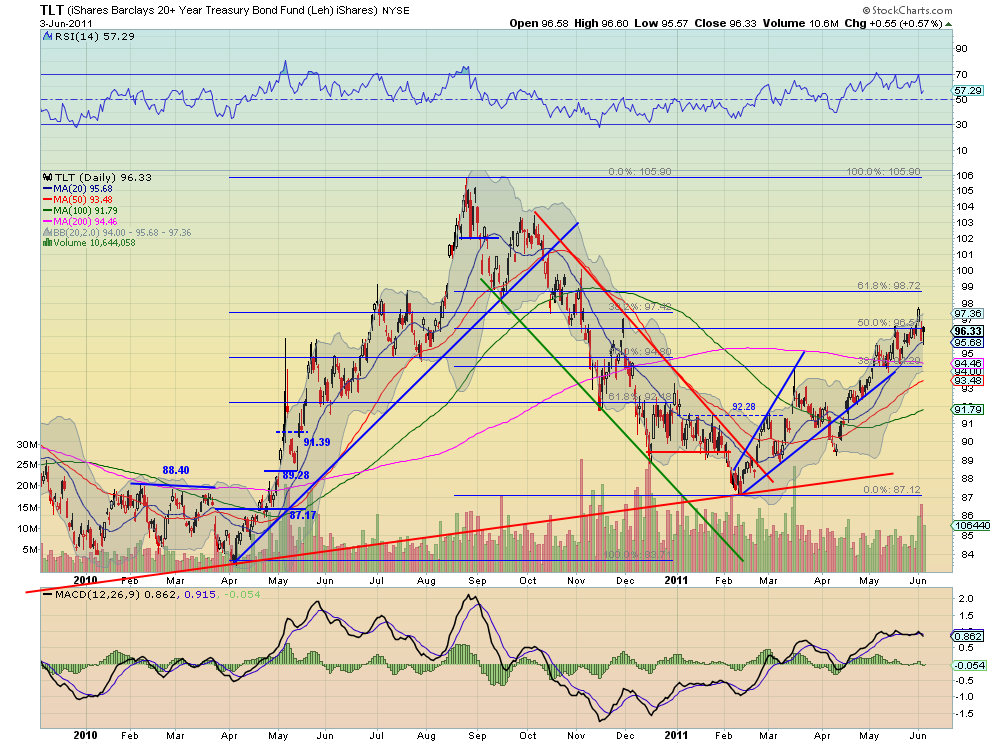
iShares Barclays 20+ Yr Treasury Bond Fund Weekly,$TLT
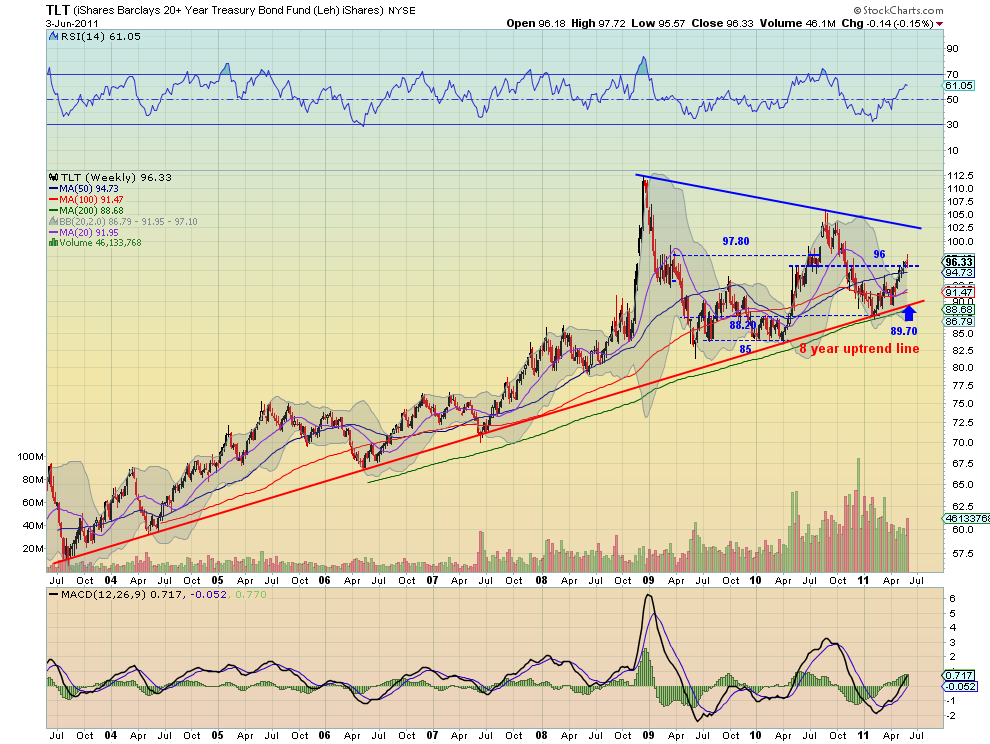
Treasuries, as measured by the TLT ETF, probed higher before falling back to support of the 20 day SMA at 95.68 and bouncing back to the 96.51 Fibonacci level. These are now short term resistance and support. The daily chart shows the RSI may be ready to turn higher again, but the MACD is crossed lower, but relatively flat. It could go either way from this chart. The weekly chart shows that indecision by way of long upper shadowed doji printed, nearly touching the 97.80 resistance and reaching just under the 96 support. The RSI on the weekly chart is rising, but flattening, as is the MACD, suggesting more upside, and that agrees with the trend since February. But add that together with the declining volume and the doji and the picture says there may have been a top set. A move below 94.20 would confirm more downside. If it gets over 97.8 then I like the upside to continue to test 100. Remain with the uptrend for next week until proven other wise.
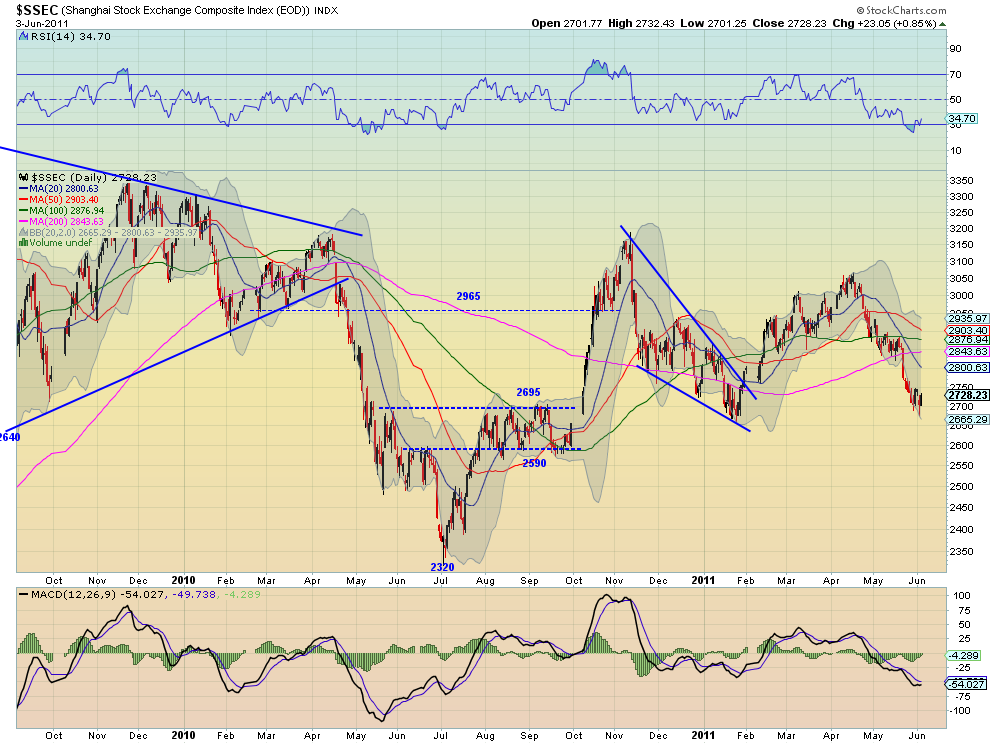
Shanghai Stock Exchange Composite Weekly,$SSEC

The Shanghai Composite consolidated in a bear flag at support 2695-2700 this week after a big fall last week. This allowed the RSI to work off the slightly oversold condition and the MACD to work back to level. The SMA’s turning lower suggest more downside. The weekly chart concurs with a falling RSI and a MACD growing more negative. Look for more downside short term but maybe more consolidation first with upside resistance at 2800 and a move above that changing the trend. A Measured Move (MM) lower would take it to the bottom of the support channel at 2590.
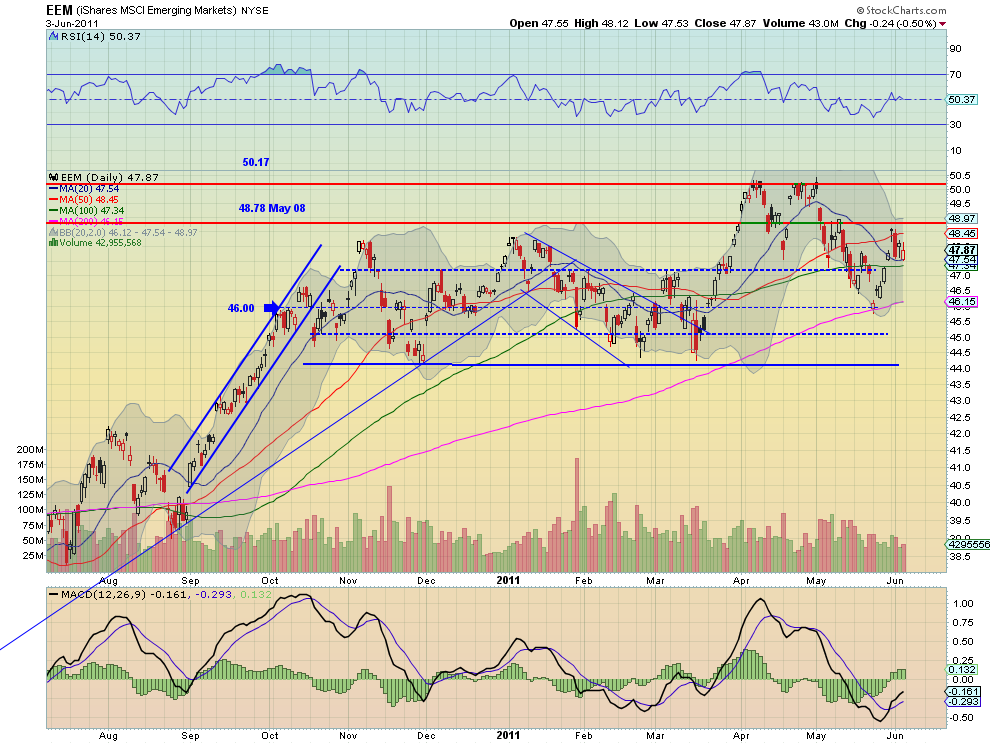 iShares MSCI Emerging Markets Index Weekly,$EEM
iShares MSCI Emerging Markets Index Weekly,$EEM
Emerging Markets, as measured by the EEM ETF, consolidated in their own flag of sorts over the 20 day SMA at 47.54 and below long term support/resistance at 48.78. The RSI on the daily chart shows this indecision resting on the mid line, but the MACD is diverging higher suggesting more upside. The weekly chart shows a solid black candle for the week holding over the 20 week SMA, and just under resistance. The flat RSI and MACD give little guidance for the next move. Look for a move above 48.78 to trigger another run to 50.17 but failure at 48.20 to lead to further consolidation in the channel above 44.30. So flat with a slight bias higher for the coming week.

VIX Weekly,$VIX

The Volatility Index tested both ends of the recent range again at 15 and 20 before settling in the middle. The SMA, RSI and MACD on both the daily and weekly charts are all still very flat and give little clue as to where the next move will be. Look for a continued tight range at relatively low levels within that range with upside possible up to 21.25 before any worries of increasing volatility.
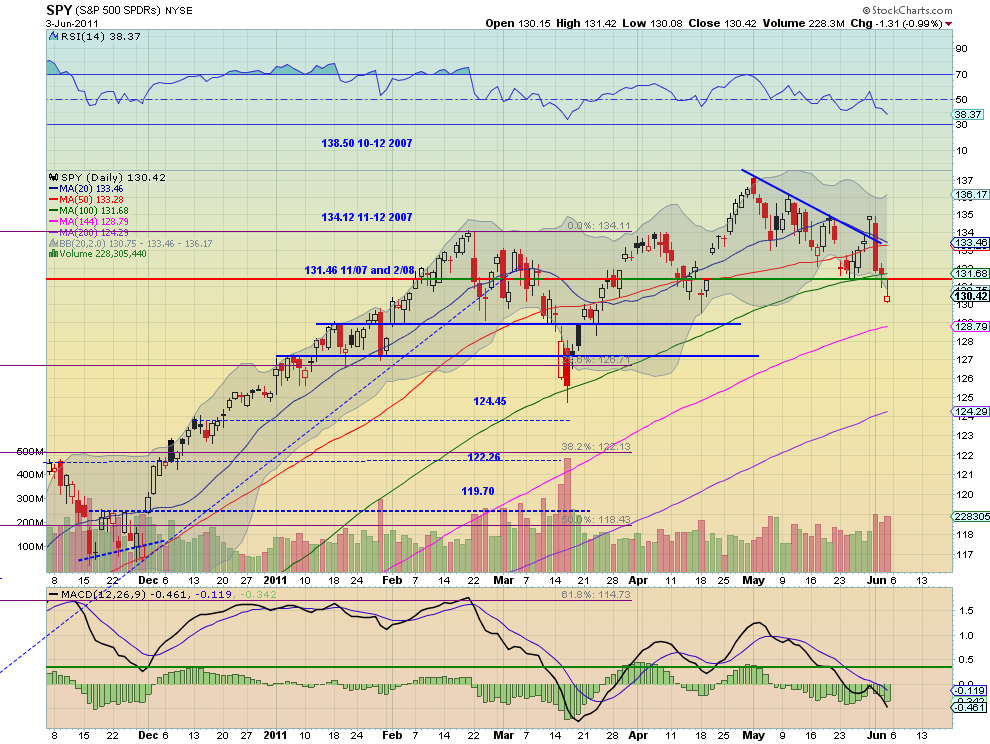
SPY Weekly,$SPY
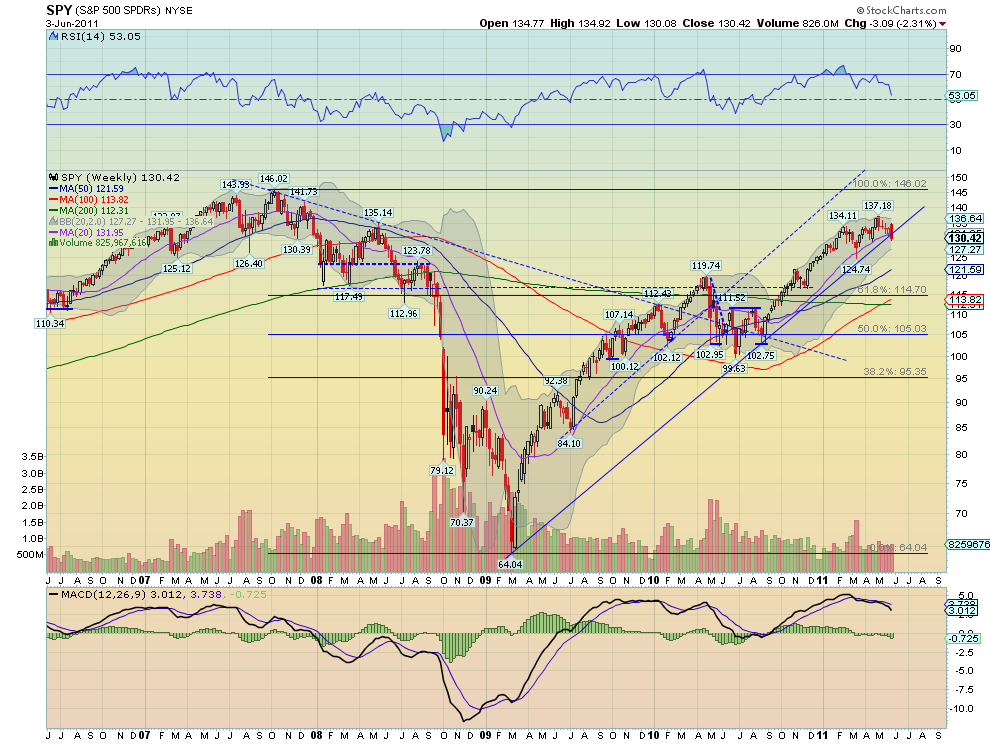
The SPY popped to a higher high on Tuesday over the downtrend resistance only to fall back and continue lower the rest of the week closing with a Hollow Red Inverted Hammer Friday near support at 130 and a lower low. A possible reversal signal after a hard move lower. It also closed under the 100 day SMA for the first time since September, when the rally began. The RSI and MACD suggest that there is more downside to come and the elevated volume confirms that. The weekly chart shows a bearish engulfing candle through the uptrend support line and the 20 week SMA. The RSI is heading sharply lower and the MACD is increasing negative. Look for next week to bring more downside, minding the inverted hammer, with support next at the 129 area near the 144 day SMA and then 127.
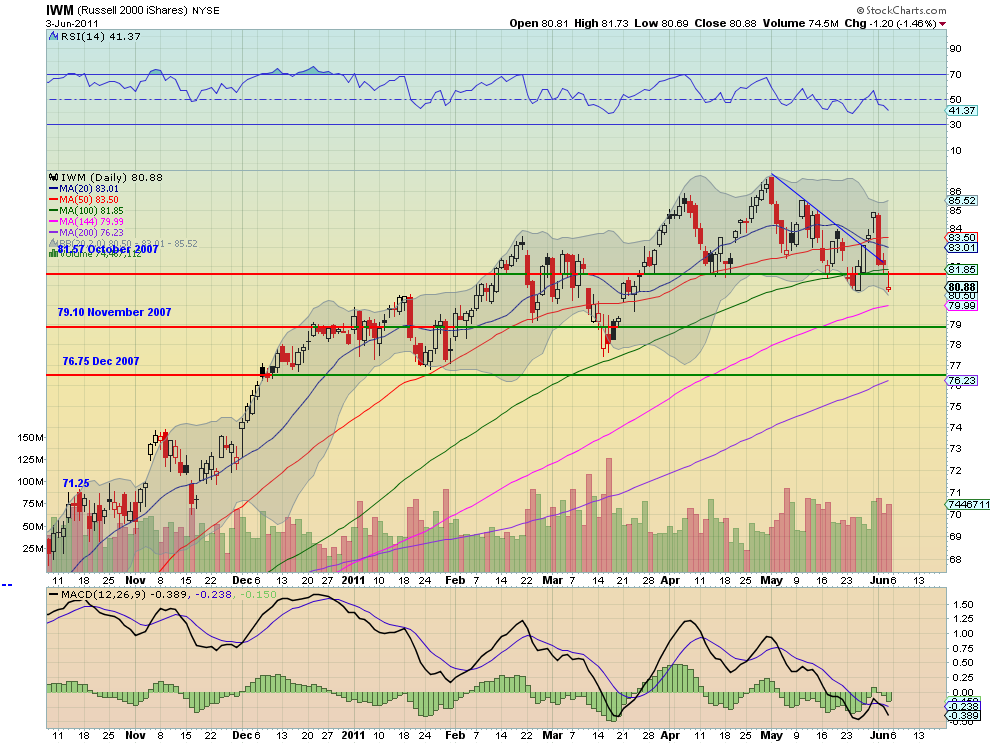
IWM Weekly,$IWM
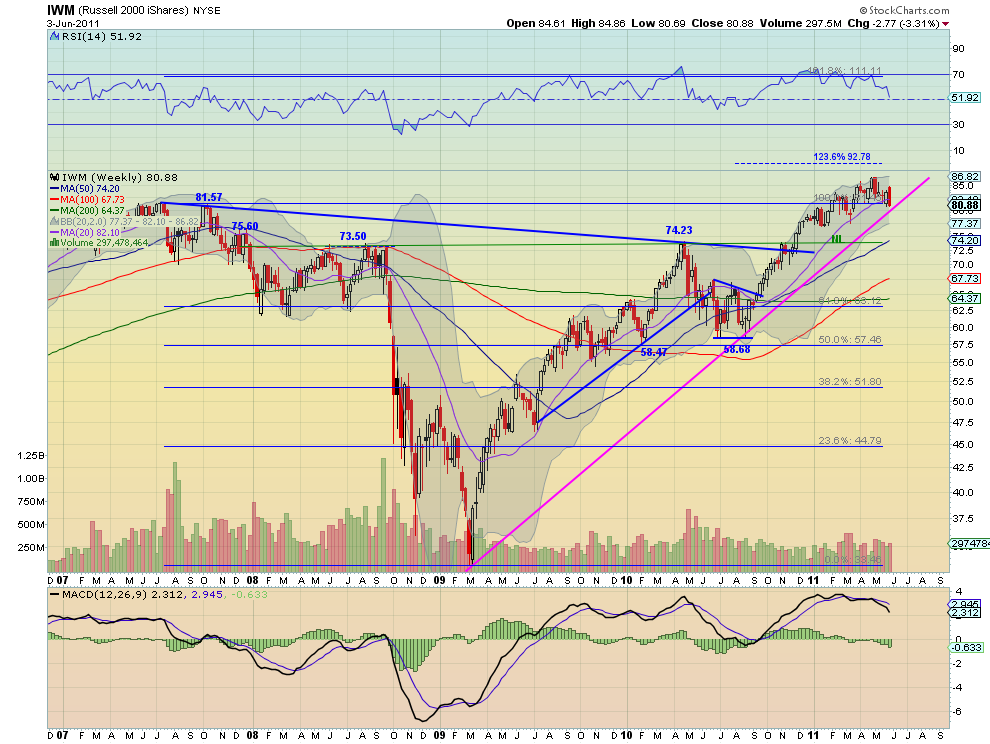
The IWM also popped to a higher high on Tuesday over the downtrend resistance only to fall back and continue lower the rest of the week closing with a Hollow Red Inverted Hammer Friday near support at 80.60 and a lower low. It also closed under the 100 day SMA for just the third time since September, the other two being last week. The RSI and MACD suggest that there is more downside to come. The weekly chart shows a bearish engulfing candle just above the uptrend support line and under the 20 week SMA. The RSI is heading sharply lower and the MACD is increasing negative. Look for next week to bring more downside, minding the inverted hammer again, with support next at the trend at 80 near the 144 day SMA and then 79.10 and 77.

QQQ Weekly,$QQQ

The QQQ followed suit also popping to a higher high on Tuesday over the downtrend resistance only to fall back and continue lower the rest of the week closing with an Inverted Hammer Friday near support at 56.20, and a lower low. The RSI and MACD suggest that there is more downside to come. The weekly chart shows a bearish engulfing candle at the uptrend support line and under the 20 week SMA. The RSI is heading sharply lower and the MACD is increasing negative though only slightly. Look for next week to bring more downside, minding the inverted hammer again, with support next at 56.20 near the 144 day SMA and then 55.50 and 54.26.
The coming week look to continue the trend higher for Gold with Crude Oil drifting sideways to slightly higher. The US Dollar Index should continue lower while US Treasuries remain in an uptrend but with a potential reversal looming. The Shanghai Composite could continue its flag or head lower while Emerging Markets continue their flag or head higher. Volatility should remain subdued but start to watch for a break of 21.25 to change that. The Equity Index ETF’s, SPY, IWM and QQQ are all on the same page again and look lower. Use this information to understand the major trend and how it may be influenced as you prepare for the coming week ahead. Trade’m well.
Editorial Note: My service provider is no longer providing open-hi-lo, but only close data for Gold, Crude Oil and the US Dollar Index. I will be making a decision about substituting ETF’s for the going forward vs using close only data. If you have a preference please leave your thoughts in the comments.
Etichette:
Analysis Technic,
analysis technic article,
articles,
crude oil,
Currencies,
dollar index,
eMini SP,
energy,
financials,
gold,
Index,
metals
Economic Whiplash
By John Mauldin
Non-Farm Payrolls Even Worse than the Headline
Velocity Rolls Over
Intolerable Choices for the Eurozone
And It Just Gets Worse
Tuscany
>
Do you feel as if you are suffering from some sort of economic whiplash? Between focusing on the European crisis (and it is a crisis), then looking at softening data in the US and political turmoil in Japan, not to mention the Middle East, you can be forgiven for feeling like someone just slammed into the back of your “economic recovery car.” This week we look at today’s US employment numbers, then at a troubling slowing of economic velocity, precisely at a time when it should be rising, and then consider a powerhouse, must-be-read-twice commentary from Martin Wolf on the European situation. Then I will weigh in with some of my own thoughts. Counterintuitively, the holders of certain European debt are being put at further risk by the bailout. (This letter may be a little shorter and take more work than others –which some of you think will improve it – as I am suffering from Caesar’s Revenge here in Tuscany, although I am getting better!)
As you know, I am a firm believer that the state of the global economy is such that we as investors have to be especially agile and focused today. Consequently I spend a great deal of time and effort looking into alternative investment strategies and managers. I’m very pleased to announce that I am relaunching my special newsletter for accredited investors, to share the latest opportunities and pitfalls in alternative assets.
The good news is that this Accredited Investor Letter is completely free. The only restriction is that, because of securities regulations, you have to register and be vetted by one of my trusted partners before you can be added to the subscriber roster. They include Altegris Investments in the US, Absolute Return Partners in Europe, Nicola Wealth Management in Canada, and Fynn Capital in Latin America. This is a painless process (I promise!), and just to sweeten the pot, after you register my partner will provide you access to the video of Gary Shilling’s speech from my Strategic Investor Conference in La Jolla. I don’t need to remind you how insightful Gary is, but if you’ve never seen him speak, let me just tell you that he’s absolutely compelling.
[[Click here now to register]] and you’ll be part of the summer relaunch of my letter exclusively for accredited investors. In the meantime, enjoy Gary’s video presentation and benefit from his intelligence as you plot your investment course. Over time, we will make all the conference videos available to the subscribers of the free Accredited Investor E-letter. Those who attended the conference, or have spoken with an Altegris professional, already have access to all the speeches and panels.

I do not like limiting the letter to accredited investors, but those are the rules under which I work. This is not of my choosing, and I have worked in front of and behind the scenes to try to change what I think is a very unfair rule. (See important risk disclosures below. In this regard, I am president and a registered representative of Millennium Wave Securities, LLC, member FINRA.) And now to the letter.
Velocity Rolls Over
Quickly, the following came to my inbox from my friends at GaveKal. They chart their own private calculation of the velocity of money. Notice in the chart below that the velocity of money was screaming “Problem!” during the recent crisis, began to improve with the recovery in 2009, rolled over with the end of QE1, and started to improve again (more or less) with QE2. Now, with QE2 ending, velocity is already down and falling, which is worrisome, as this comment shows. (Understand, the guys at GaveKal are typically looking for reasons to be bullish.)
“As we have highlighted in recent Dailies, our Velocity Indicator has been heading south rather rapidly. At first glance, this might appear surprising as there are few signs of stress in the financial system today: corporate spreads are decently tight, IPOs continue to roll out, and the VIX remains low. Sure, Greek debt has now been downgraded below Montenegro’s and stands at the same ratings as Cuba’s, but even acknowledging this, the recent depths reached by our Velocity Indicator is still somewhat surprising. Why, in the face of fairly benign markets, is our indicator so weak?
“The answer is very simple and it is linked to the recent underperformance of banks almost everywhere. Indeed, with short rates still low everywhere, and yield curves positively sloped, we are in the phase of the cycle when banks should be outperforming. The fact that they are not has to be seen as a concern. So does the underperformance come from the fact that the market senses that losses have yet to be booked (Europe?)? Is it a reflection of a lack of demand for loans (US?) or that more losses and write-offs are just around the corner (Japan?)? Is the bank underperformance signaling that we are on the verge of a new banking crisis, most likely linked to the possibility of European debt restructurings? Or perhaps it is linked to the coming end of QE2 and consequential tightening in the liquidity environment (see our Quarterly
published earlier today for more on this topic)?
“In our view, any of the above could potentially explain the recent bank underperformance. But whatever the reasons may be, it has to be seen as a worrying sign. One of our ‘rules of thumb’ is that if banks do not manage to outperform when yield curves are steep, the market must be worried about the financial sectors’ balance sheets (given that, with a steep yield curve, there are few reasons to worry about the bank’s income statement).”

As I have noted before, Martin Wolf is one of my all-time favorite writers. He alone is worth a subscription to the Financial Times (www.ft.com). I highlight below a column he did earlier this week. It presents the rather stark choices faced by Europe. This sentence from the 5th paragraph is spot on: “Moreover, because national central banks have lent against discounted public debt, they have been financing their governments. Let us call a spade a spade: this is central bank finance of the state.” If such a situation is allowed to prevail, it has to undermine the value of the euro. My comments, after you read this slowly and thoughtfully.
“Intolerable Choices for the Eurozone”
By Martin Wolf
“The eurozone, as designed, has failed. It was based on a set of principles that have proved unworkable at the first contact with a financial and fiscal crisis. It has only two options: to go forwards towards a closer union or backwards towards at least partial dissolution. This is what is at stake.
“The eurozone was supposed to be an updated version of the classical gold standard. Countries in external deficit receive private financing from abroad. If such financing dries up, economic activity shrinks.
Unemployment then drives down wages and prices, causing an ‘internal devaluation’. In the long run, this should deliver financeable balances in the external payments and fiscal accounts, though only after many years of pain. In the eurozone, however, much of this borrowing flows via banks. When the crisis comes, liquidity-starved banking sectors start to collapse. Credit-constrained governments can do little, or nothing, to prevent that from happening. This, then, is a gold standard on financial sector steroids.
“The role of banks is central. Almost all of the money in a contemporary economy consists of the liabilities of financial institutions. In the eurozone, for example, currency in circulation is just 9 per cent of broad money (M3). If this is a true currency union, a deposit in any eurozone bank must be the equivalent of a deposit in any other bank. But what happens if the banks in a given country are on the verge of collapse? The answer is that this presumption of equal value no longer holds. A euro in a Greek bank is today no longer the same as a euro in a German bank. In this situation, there is not only the risk of a run on a bank but also the risk of a run on a national banking system. This is, of course, what the federal government has prevented in the US.
“At last month’s Munich economic summit, Hans-Werner Sinn, president of the Ifo Institute for Economic Research, brilliantly elucidated the implications of the response to this threat of the European System of Central Banks (ESCB). The latter has acted as lender of last resort to troubled banks. But, because these banks belonged to countries with external deficits, the ESCB has been indirectly financing those deficits, too. Moreover, because national central banks have lent against discounted public debt, they have been financing their governments. Let us call a spade a spade: this is central bank finance of the state.

“The ESCB’s finance flows via the euro system’s real-time settlement system (‘target-2’). Huge asset and liability positions have now emerged among the national central banks, with the Bundesbank the dominant creditor (see chart). Indeed, Prof Sinn notes the symmetry between the current account deficits of Greece, Ireland, Portugal and Spain and the cumulative claims of the Bundesbank upon other central banks since 2008 (when the private finance of weaker economies dried up).
“Government insolvencies would now also threaten the solvency of debtor country central banks. This would then impose large losses on creditor country central banks, which national taxpayers would have to make good. This would be a fiscal transfer by the back door. Indeed, that this is likely to happen is quite clear from the striking interview with Lorenzo Bini Smaghi, a member of the board of the European Central Bank, in the FT of May 29 2011.
“Prof Sinn makes three other points. First, this backdoor way of financing debtor countries cannot continue for very long. By shifting so much of the eurozone’s money creation towards indirect finance of deficit countries, the system has had to withdraw credit from commercial banks in creditor countries. Within two years, he states, the latter will have negative credit positions with their national central banks – in other words, be owed money by them. For this reason, these operations will then have to cease. Second, the only way to stop them, without a crisis, is for solvent governments to take over what are, in essence, fiscal operations. Yet, third, when one adds the sums owed by national central banks to the debts of national governments, totals are now frighteningly high (see chart). The only way out is to return to a situation in which the private sector finances both the banks and the governments. But this will take many years, if it can be done with today’s huge debt levels at all.
“Debt restructuring looks inevitable. Yet it is also easy to see why it would be a nightmare, particularly if, as Mr Bini Smaghi insists, the ECB would refuse to lend against the debt of defaulting states. In the absence of ECB support, banks would collapse. Governments would surely have to freeze bank accounts and redenominate debt in a new currency. A run from the public and private debts of every other fragile country would ensue. That would drive these countries towards a similar catastrophe. The eurozone would then unravel. The alternative would be a politically explosive operation to recycle fleeing outflows via public sector inflows.
“Events have, in short, thoroughly falsified the premises of the original design. If that is the design the dominant members still want, they must remove some of the existing members. Managing that process is, however, nigh on impossible. If, however, they want the eurozone to work as it is, at least three changes are inescapable. First, banking systems cannot be allowed to remain national. Banks must be backed by a common treasury or by the treasury of unimpeachably solvent member states. Second, cross-border crisis finance must be shifted from the ESCB to a sufficiently large public fund. Third, if the perils of sovereign defaults are to be avoided, as the ECB insists, finance of weak countries must be taken out of the market for years, perhaps even a decade. Such finance must be offered on manageable conditions in terms of the cost but stiff requirements in terms of the reforms. Whether the resulting system should be called a ‘transfer union’ is uncertain: that depends on whether borrowers pay everything back (which I doubt). But it would surely be a ‘support union’.
“The eurozone confronts a choice between two intolerable options: either default and partial dissolution or open-ended official support. The existence of this choice proves that an enduring union will at the very least need deeper financial integration and greater fiscal support than was originally envisaged. How will the politics of these choices now play out? I truly have no idea. I wonder whether anybody does.”
And It Just Gets Worse
It now appears that a “troika” of the ECB, the EU, and the IMF will bail out Greece yet again. They clearly cannot go to the private market. But what happens in 2013 when financing is once again needed? The lucky bond holders who have debt maturing in the next two years get 100% on the euro. Without another large bailout, the other bond holders will be lucky to get 30 cents on their debt. And this is just Greece.
The “troika” is doubling down on its losing bet in Greece and is playing with the dice loaded against them. With debt-to-GDP over 160% in just a few years, how can Greece work it out? And that is with very optimistic assumptions about GDP in a country whose government will be in severe austerity mode. GDP is likely to fall significantly, not rise slightly.
Martin Wolf is as wired in to the leadership of Europe as anyone. If he does not know how this plays out, you can bet the leaders don’t either. Milton Friedman predicted (I think in 1999) that the euro would only last until the first real financial crisis. We are almost there. If it looks like the leaders of Europe are unsure what the game plan should be, it is because they have no idea beyond kicking the can down the road and hoping that something turns up.
The political winds in Europe are shifting. The crowd that runs the various member countries today, making decisions, etc., will not long survive the changes. I think there will be new politicians with different mandates as it becomes clear that the costs of the bailout are going to fall on the tax backs of the solvent countries and that austerity is going to mean hellishly bad deflation, high and rising employment, and depression in the indebted countries.
There is $600 trillion in derivatives now loose in the world. Who knows which banks have written them and to whom? Who are the counterparties? We did not fix this with the last political fix. The next crisis has the potential to be just as bad or worse than 2008, which is why I think Europe’s leaders are so dead set on avoiding a day of reckoning. If you look under the hood, as they most assuredly have, it must be frightening. And with pushback from voters?
Contagion, thy name is Europe. And with the US economy slowing down, it might not take much to push us over the edge. We need to pay attention to European politics, which if anything is more arcane than that of the US. Stay tuned.
Tuscany
Five of my kids, three spouses or significant others, and a grandchild are here with me in Tuscany. Some of us have been a little under the weather, but are starting to feel better, and we did gamely go touring. I so love this part of the world, and the weather has been cool enough to be pleasant at night.
The next few weeks will see my kids (except for Trey) leave this weekend, and then friends from all over are coming to share the villa with us. Tiffani and Ryan and I will be working during the day and sharing company and good times with our guests in the evening. And now they are calling dinner.
… And what a dinner it was. We had a local chef come in with fresh food, homemade pasta, and all sorts of goodies. LOTS of Prosecco. Plus, Mother Nature put on a show for us. Sitting out eating under the canopy, we watched a lightning and rain storm worthy of West Texas spread out over the Tuscan hills. The French, in a 100-year drought and not that far away, must be jealous. So would West Texas today.
I am not sure I can remember when life has been better.
Night before last we went to a local destination restaurant, Il Conte Matto (The Mad Count), 100 meters from our house, and with the 600-year-old city wall running through it. I have to make a confession that is hard for this Texan to make. I normally do not order steak in Europe. In general, it is tough and tasteless. There are other dishes which are excellent that I can focus on. (Sorry, Scotland.) But the filet I had was as tender as any I have ever had. It is from a local breed called Chianina, which is a porcelain-white breed of cattle.
They are huge, the largest cattle in the world. Average for a bull is 3,500 pounds, with the largest weighing in at 3,850. Taller than anyone but Dirk (who was awesome last night against Miami). Ten feet long. I would have bet something so large would be tougher than nails, but I would have lost that bet. (Google them.) I will take that walk down the street to Il Conte Matto a few more times. And the local Italians have learned how to do Chardonnay California style. Awesome.
Time to hit the send button. The kids are waiting for Dad to join them for the final night. Have a great week. I know I am.
Your wishing I could speak some Italian analyst,
Etichette:
articles,
Economy article,
Finance article,
market articles
Subscribe to:
Posts (Atom)






